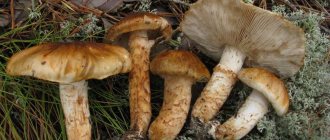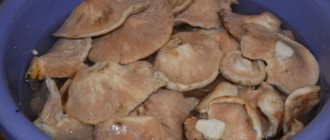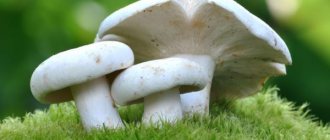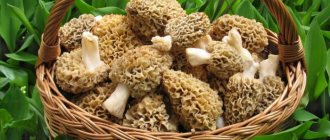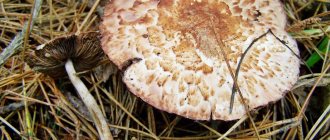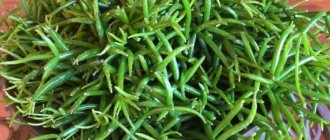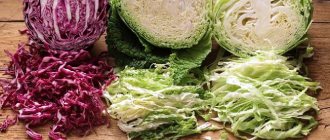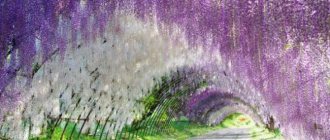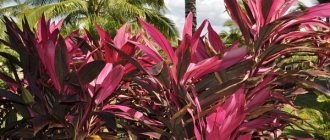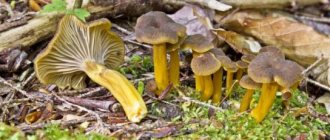Types of mushrooms, appearance
Many people often like to walk in the forest and pick mushrooms. But it is worth knowing what edible mushrooms look like in a pine forest, so as not to make a mistake and accidentally pick inedible mushrooms, which can be dangerous to health and life. In a pine forest or under spruce trees you can find mushrooms of different colors with different names and tastes that are allowed to be eaten. There are gray and brown mushrooms, and you can also find white mushrooms and any other color in the coniferous and pine forests.
There are the following main types of mushrooms growing in pine forests:
- Butter. The oiler is brown in color, yellow inside, and small in size. Since boletus loves warmth, they can often be found at the edge of a field or at the edge of a field.
- Honey mushrooms. It is found not only under pine trees in the forest, but also grows in fields, meadows, or even among bushes. The stem of pine mushrooms is tall and long, and the cap is disc-shaped and dark brown.
- Row. You can find such pine mushrooms in old forests. The mushrooms got their name because they grow in a row. The cap comes in different sizes and sometimes reaches up to 15 cm in diameter.
- Greenfinch . They are part of the row family and are distinguished by their green-yellow color. These are late autumn mushrooms. The stem of the mushroom is straight and slightly wider at the bottom.
- Moss fly. In pine forests you can often find mushrooms that grow in places covered with moss. The moss cap is thick and the leg is high.
- Russula . A fairly popular pine mushroom that is found everywhere. There are many varieties of russula that differ in size and appearance. The stem of the russula is white, and the cap can be of different colors, depending on the environment in which the mushroom grows.
- Chanterelles. A unique mushroom that can be found in pine forests and plantings. The color of the chanterelles is rich orange, and the cap is funnel-shaped.
- Umbrella mushroom. These pine forest mushrooms are distinguished by their thin stalk and outstretched hat, reminiscent of a dome or umbrella.
- Boletus or porcini mushroom. A popular mushroom that many mushroom pickers try to find. The average size of such mushrooms is 30 cm, but sometimes there are specimens whose cap reaches 50 cm in diameter. The leg of the boletus is thick and the cap is round.
It is worth knowing exactly what mushrooms grow in pine trees and which can be eaten, since there are also inedible pine mushrooms, which include the following:
- fly agaric;
- death cap;
- the smell is false.
Ryzhik
Camelina is one of those mushrooms that grow under pine and spruce. There is pine camelina, which has an orange or red-orange cap. Spruce camel has a yellowish or lilac-greenish tint. The fruiting individuals of this species are covered with mucus. When you cut or touch it, green spots appear. It has a pronounced smell of milky juice.
Spruce mushrooms feel best in places where moss grows, there are small hummocks, and also near lingonberries and blueberries.
The pine species is most often found in drier areas of the forest, on small hills near young pines.
The mushroom is best suited for marinating and frying in sour cream.
Where, when and how do they grow?
You can find mushroom glades among spruce and pine forests. Many mushrooms grow in September-October, while others can be found at a later time or in the summer during the good rainy season.
Some mushrooms, such as chanterelles, grow in places with high humidity. Other edible mushrooms, such as boletus mushrooms, grow in warm places - on the edges of a pine forest or other parts of a pine forest that receive a lot of sunlight. Some mushrooms cannot be found on the ground, since they grow exclusively on pine trees.
Butter
Oiler is the name of a huge group of mushrooms from the Boletaceae family, which includes about 40 representatives. The main difference between the family is that all its representatives have an oily cap.
Perhaps this species leads the list of what mushrooms grow under pine trees in our country. Although they are found in Africa and Australia, that is, in those countries with a temperate climate.
In our forests, the common and autumn oiler are found predominantly. The fungal cap has a small bump in the center. The color is usually brownish, but there are specimens with a brown or olive tint. The peel is easily removed from the mushroom; inside there is soft and juicy pulp, yellowish in color.
The oiler feels good near young pines, but is also found in mixed forests. The mushroom loves soil with good drainage, that is, sandstone. He accepts greenfinches, chanterelles and russula as neighbors. Grows mainly in groups.
It bears fruit almost throughout the warm season, from July to October, the main thing is that the atmospheric temperature is above 18 degrees. When the temperature drops to -5, mushroom growth stops completely.
The category of what mushrooms grow under pine trees includes summer and granular butterflies. There are few differences from the autumn and ordinary species; the color of the cap is ocher-yellow. Found mainly in pine forests.
Benefit
Mushrooms growing in spruce or pine forests are quite useful for the human body. In most cases, mushrooms are eaten because they are a relatively dietary and low-calorie product, which consists of 90% water.
Many mushrooms reduce cholesterol in the body and improve the human condition in many other diseases. Also, pine forest mushrooms are often used not only in cooking, but also in cosmetology and medical purposes. Mushrooms growing in pine forests help produce enzymes.
The influence of forest age and other conditions on the species diversity of fungi
The pine forest generates phytoncides, so the air in it is considered healing and helps in healing lung diseases.
By the way. Phytoncides are volatile compounds that can kill or slow down the development of microorganisms. Pine is able to grow in the harsh northern climate on the poorest soils: both sandy with a lack of moisture and swampy.
In pine forests, mushrooms grow abundantly, forming mycorrhizae also with shrubs, ferns and herbs, connecting them with each other. Pine trees provide access to sunlight to the soil surface and do not interfere with the circulation of air flows. The ground cover is represented by green mosses, blueberry bushes, lingonberries, and junipers.
The role of mushrooms in a coniferous forest is great; thanks to their vital activity, pine needles (which make up the forest floor), dead wood and dry broken branches decompose. Fungi grow under pine trees, giving them trace elements and carbohydrates produced by fungal hyphae, and receiving nutrients from the roots in return.
Interestingly, mycorrhiza does not appear immediately, and fungal diversity directly depends on the age of the forest. The following stages can be distinguished:
- A young pine forest provides a little shade and a lot of sun, since the trees are still short, a thin layer of fallen pine needles, well-warmed earth, and little humidity. The first boletus - the pioneers of pine plantings - can appear in as little as 2 years.
In addition to the age of the trees, which, of course, regulate the internal atmosphere in the forest, climate also matters. In dry years, the rate of mycorrhiza development is much slower. They contribute to changes and disasters, for example, strong winds that knock down trees.
Application
In cooking
Many mushrooms growing in pine trees have very good taste, so they are widely used in cooking. Pine mushrooms are pickled and pickled for the winter; they come out very tasty and crispy. Mushrooms are also added to the soup. They can be used fresh or dried. Fried mushrooms with fresh potatoes turn out delicious.
You can find many interesting and tasty recipes that use pine mushrooms. Pine forest mushrooms are also used for the following purposes:
- winemaking;
- bakery business;
- making sweets;
- creation of rennet cheeses.
In medicine
Pine mushrooms are distinguished by their healing properties. Chanterelles, for example, are useful for people who have impaired liver function, and these mushrooms also have an anthelmintic effect. Boletus or porcini mushroom helps stimulate metabolic processes in the human body. Boletus mushrooms are also indicated for tuberculosis, since they suppress the activity of the tuberculosis bacillus.
Based on some other mushrooms, medicinal extracts are made to fight parasites, treat sore throat, stomach ulcers, bronchial asthma, or get rid of signs of an allergic reaction.
Answers to common questions
Forest mushrooms attract lovers of delicious food, but also raise many questions. It is useful to listen to the opinion of a specialist answering some of them.
But the most effective technique is to soak the mushroom bodies in water with salt and citric acid. Then, along with the sand, a lot of other debris will separate, including pests hiding in the folds. True, you shouldn’t keep it in water for a very long time; half an hour will be enough. The pulp absorbs moisture very strongly, which reduces the taste.
The pine forest is both a hospital with healing air, and a home for many animals, and a storehouse of nutritious fruits for both animals and people. On a quiet hunt you need to be careful with edible mushrooms.
Harm and contraindications
Despite their great benefits, pine mushrooms can also harm humans if they are used or stored incorrectly. Any edible mushroom growing in a pine forest is a heavy food, and therefore is not recommended for people with diseases of the gastrointestinal tract, liver, or impaired kidney function. Dishes with mushrooms are contraindicated for persons who have an allergic reaction to mold.
Even edible mushrooms collected within the city, where there are a lot of cars, are dangerous for any person. This is due to the fact that pine mushrooms, like any other, accumulate toxic substances from the environment.
Harvesting Rules
It is very easy to recognize the mushrooms that grow under the pine tree. There are plenty of photos on the Internet; almost every home has a book on mushrooms. But even edible mushrooms can be dangerous to humans if certain rules are not followed:
- Picking mushrooms near highways and railway tracks is prohibited. There is a high risk that they will contain heavy metal salts and other harmful substances.
- Collect only those specimens that you are sure of. You shouldn’t taste them, especially not let children do it.
- Inspect the mushrooms carefully: they should not be damaged or have wormholes. When you come home again, inspect the harvested crop and discard damaged specimens.
- Do not pull out the mushroom along with the mycelium. If you do this, then after a couple of weeks there will be no new mushrooms in this place.
We suggest you familiarize yourself with Which lawn is best to plant at the dacha
If you have the slightest doubt, for example, if the mushroom is of an unknown species, discard it. Happy quiet hunting.
How to distinguish edible from inedible
All types of pine mushrooms are divided into edible and inedible, so everyone needs to know how to distinguish one from the other so as not to get poisoned. The surest way to distinguish an inedible mushroom from an edible one is to see this difference in practice with detailed instructions and a story from an experienced mushroom picker.
Inedible mushrooms, unlike edible ones, have a bitter taste and may smell bad. Some inedible mushrooms have an ovoid thickening at the base of the stem that looks like an egg. The gall mushroom can often be confused with boletus or porcini mushroom, since they are very similar in appearance. In the first, only when the cap is broken, a reddish or brown tint appears. The false honey fungus differs from the edible one in that its cap is yellow-green rather than yellow-brown.
Pine forest mushrooms
Experienced mushroom pickers know what mushrooms grow in a pine forest. This depends on the type of nutrients available and the climate. Mushrooms can be found both on the ground among plants, and on tree trunks and even on stones .
Mushrooms are divided into edible and inedible. All of them are parasitic organisms, but since some of them can be eaten by animals and humans, they also play a positive role. In terms of chemical composition, mushrooms are close to vegetable crops, but the amino acid set is also similar to that of animal products.
Nutritional value and chemical composition
Many pine mushrooms contain 18 amino acids and many other beneficial components. 90% of the mushroom consists of water. 100 grams of mushrooms contain the following components:
- proteins – 4 g;
- carbohydrates – 3 g;
- fats – 1 g.
Many mushrooms growing in pine forests contain organic acids, vitamins B, A, PP, E and D. Pine mushrooms also contain copper, potassium, sulfur, phosphorus, manganese, which saturate the human body and improve its functioning.
Poisonous representatives
Fly agarics cause severe poisoning
Not only edible mushrooms grow under pine trees. There are also poisonous representatives: waxy talker, pale toadstool, varieties of fly agarics and false sulfur-yellow honey fungus. Their toxins, when entering the human body, affect the central nervous system, liver, kidneys and digestive system. Without timely qualified medical care, poisoning will lead to death.
In order not to be at risk of poisoning when eating mushrooms, you need to know the characteristics of dangerous representatives of the mushroom kingdom.
- Pale toadstool: considered the most dangerous poisonous forest mushroom, the toxins of which manifest themselves after some time. The olive cap, from 5 to 15 cm in diameter, has a hemispherical shape and fibrous skin. The leg is cylindrical, with a “bag” at the base. The pulp is white, does not change color when damaged, the smell is weak.
- Panther, red and toadstool agarics: have thick, fleshy caps ranging in color from white to green. On top of them there are the remains of a blanket in which the fruiting body of the young specimen was enclosed. They resemble white flakes. The leg is straight, widened downwards. The pulp is light, with a pronounced odor. Contains strong toxins. Red fly agaric can have a hallucinogenic effect.
- Sulfur-yellow honey fungus: a false relative of the edible honey mushrooms. It is a small mushroom that grows in small groups on stumps and rotten wood. The caps are light yellow at the edges, darkening in the center, with a diameter of 2 to 7 cm. The yellowish-white flesh is characterized by a persistent unpleasant odor. The leg is thin and long. It differs from edible species in the greenish color of the fruiting body.
- Waxy talker: a poisonous representative of the Ordinaceae family. It has a white-cream wide cap with a tubercle in the center and faint concentric circles on its surface. The leg is long, widened at the bottom, with a pubescent surface, 3-4 cm in height. The pulp is white with a creamy tint, dense, with a pleasant aroma. Contains a high concentration of muscarine, which is not destroyed by heat treatment.
Irina Selyutina (Biologist):
The waxy govorushka got its name due to the presence of a white waxy layer on the surface of the flesh-colored or brownish cap. Over time, this waxy coating cracks and a kind of “marble” surface is formed. The peel is easily removed, right down to the center of the cap. The mushroom is poisonous and contains muscarine, which is not destroyed by heat treatment. It has been experimentally established that the destruction of the alkaloid muscarine is possible at temperatures exceeding 100℃ with the appearance of a slight odor of tobacco. When eating large doses of waxy talker, death is noted somewhere in the range of 2-3% after 6-12 hours.
If, after eating mushrooms, you notice symptoms of poisoning from poisonous mushrooms in yourself or your loved ones, consult a doctor immediately.
Preparation and storage
Mushrooms collected in the pine forest can be dried for the winter. This method is quite simple, and mushrooms can be stored compactly. They should first be cleared of debris and soil. You can dry mushrooms naturally by stringing them on a thread, or use a dryer or oven.
Another popular way to prepare mushrooms for the winter is pickling and pickling. There are many interesting and simple recipes, thanks to which pine forest mushrooms will be stored for a long time and will turn out tasty and crispy.
What edible mushrooms grow under pine trees
You need to know how to look for edible mushrooms located under pine trees. And for this it is important to know what they look like. Some of them have dangerous doubles, which the eye of an inexperienced mushroom picker may not be able to immediately distinguish.
Porcini mushroom
One of the most favorite fruits for many mushroom pickers. It is also the most valuable representative of the Boletaceae family. It has a cap with a circumference of 8-25 cm and a thick stem - from 7 to 16 cm. The pulp is white, has a pleasant aroma, and does not change color when broken or cut.
The color of the fruit is light cream, and a fine mesh can be seen on its surface. It grows in coniferous forests where the soil is sandy. It is collected from June to October.
Saffron milk caps
Saffron milk caps belong to the Milky family. They have a bright red hue with reddish notes, which is why they got their name. The cap has concentric rings. Its edges are curved downwards, and its circumference varies between 5-12 cm.
The stem of the fruit has the same color as the cap section. It is narrowed downward, and noticeably widens upward, and has a length of 4-10 cm.
The pulp is quite dense. When damaged, it begins to noticeably turn green. At the same time, a milky juice of a light orange hue is intensely released from the damaged area. It is recommended to collect saffron milk caps in July-September.
greenfinch
Green row is a small mushroom with a characteristic greenish color. The hat is spread out, about 15 cm in circumference. There are numerous small scales in the center.
The leg grows low - no more than 5 cm. The pulp of young fungi is whitish, but over time it becomes slightly yellowish. The color does not change on the cut. The growing period lasts from September to November.
Pine honey mushrooms
Yellow-red honey mushrooms settle on the stumps of pine trees or other coniferous trees. They grow mainly in groups; it is almost impossible to find them alone.
The hat is small, matte, scaly, and velvety to the touch. Its color is red-orange. The leg is the same in shade, but curved in shape and thin in parameters. Its height does not exceed 5-7 cm.
Chanterelles
These are unique mushrooms that can be found in pine forests and plantings. They have a bright orange or yellow-orange color.
The hat is wavy in shape, there is a visible indentation inside, and swirls and waviness on the sides. Its size ranges from 2 to 12 cm. The pulp is very fleshy, and fibrousness is noted in the leg. It becomes noticeably wider at the top.
Mokhoviki
Moss fly mushrooms are found quite often in coniferous forests. These fruits love to grow in areas abundantly covered with moss. The mushroom cap is usually colored greenish or greenish-grayish. Sometimes it is brown. When you touch it, it feels velvety. The shape is slightly convex.
The mushroom stem grows up to 3-11 cm, cylindrical, expanding upward. Sometimes a brownish mesh can be seen on it.
Variegated umbrella
The cap of the umbrella mushroom is covered with a fibrous layer. It can be gray or beige, with dark brown scales on its surface. In young fruits it is spherical, in more mature ones it becomes spread out, resembling an umbrella.
The leg can be quite long - from 10 to 35 cm. It has scaly rings on its surface, or a simple ring with particles of the bedspread.
The pulp is loose to the touch, has a white color and a pleasant mushroom aroma. The umbrella mushroom tastes like champignons or walnuts.
Purple row
The unusual appearance of this fruit attracts the attention of mushroom pickers. The row has a distinct lilac color when young, but fades slightly over time, becoming lavender.
The cap is small - only 6-15 cm. The shape is mostly flat, but can be slightly convex. The cap part is quite dense and fleshy. Its edges are uneven.
The leg is not high - from 4 to 8 cm, and its thickness can reach 1.5 - 2.5 cm. It is smooth, covered with a fibrous layer, becoming thicker towards the base. The pulp is quite elastic and fleshy. It is purple in color and has a fruity aroma.
